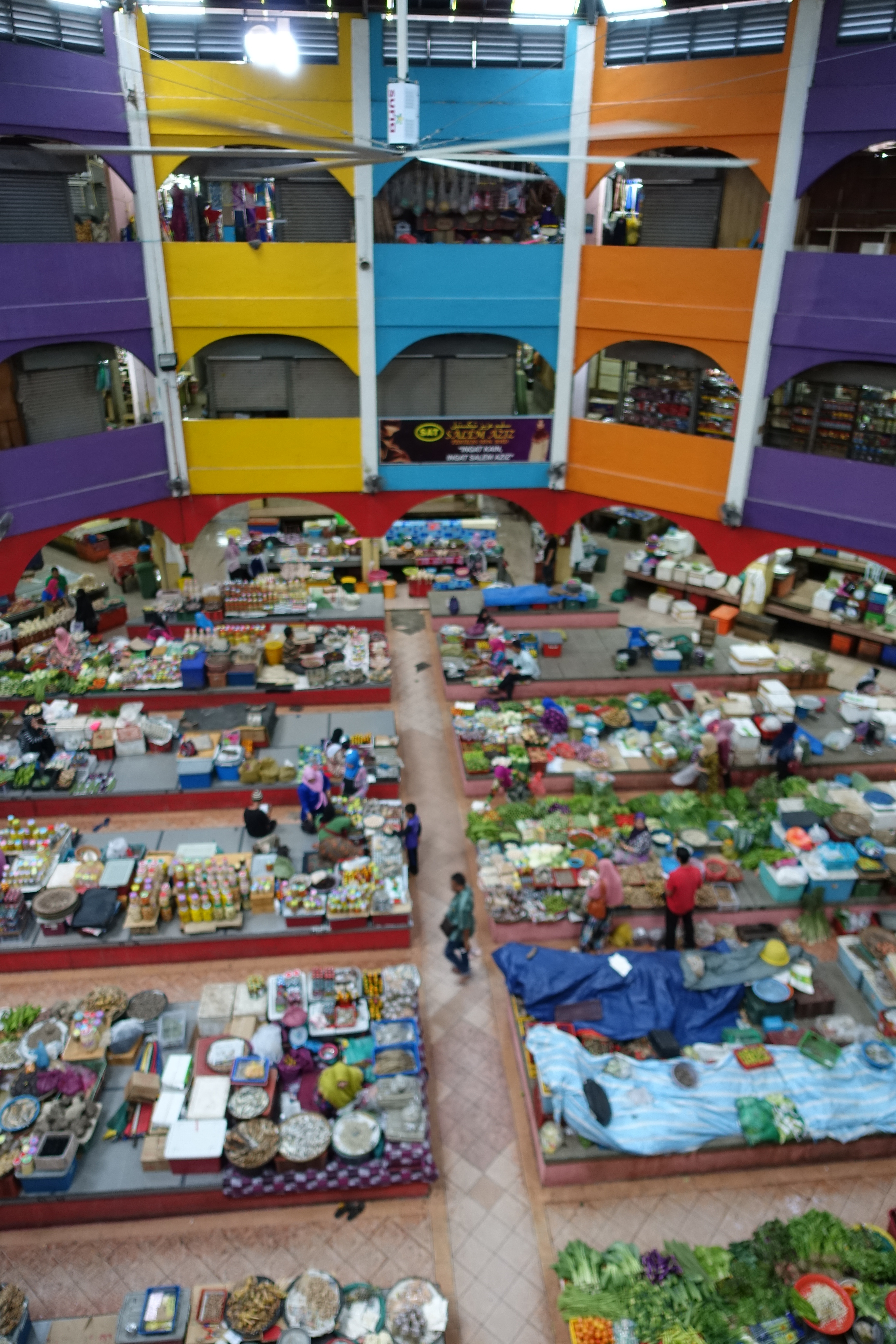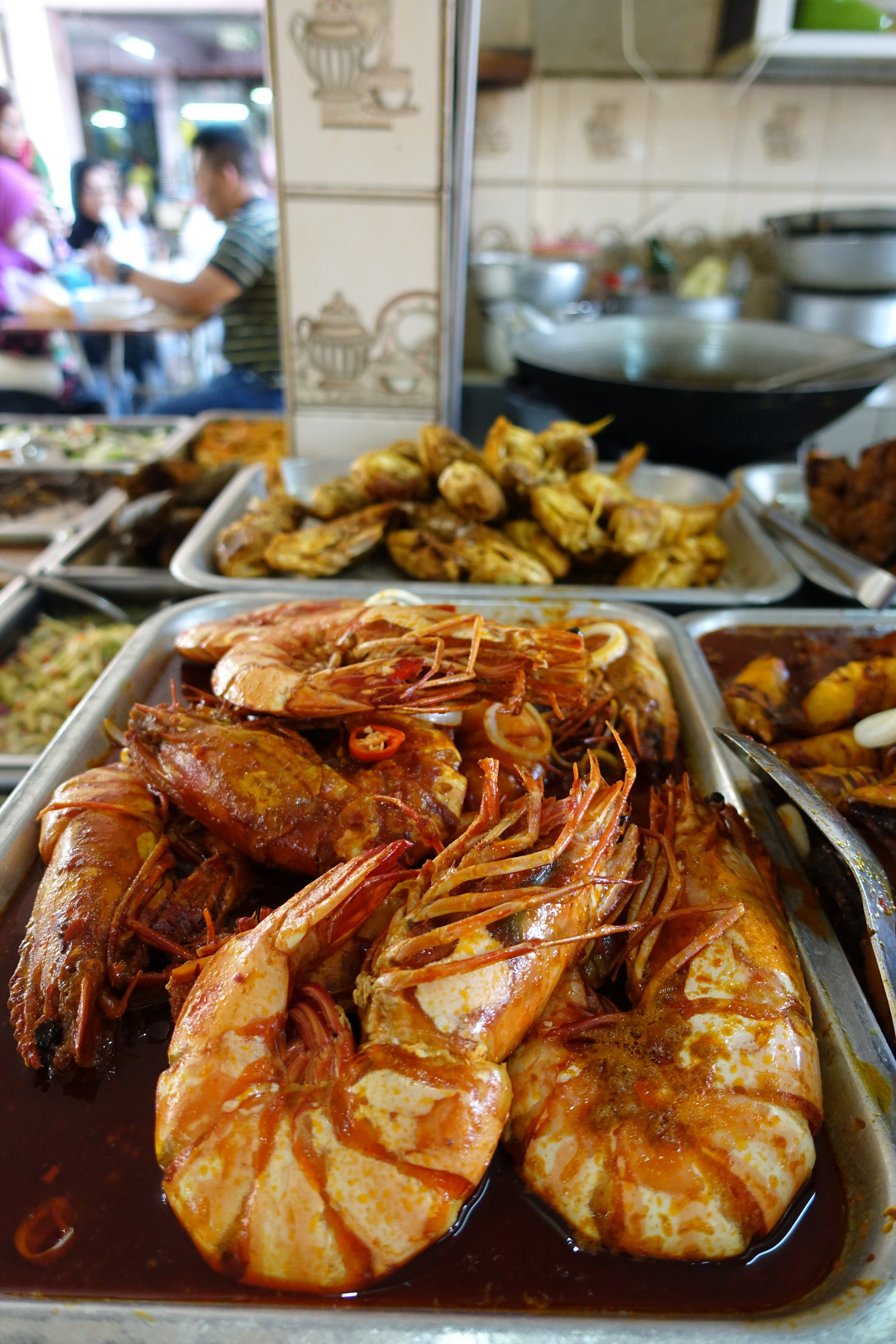Pasar Besar Siti Khadijah (or Siti Khadijah Main Market) is a hive of morning market activity in the heart of Kota Bharu at the break of dawn each day. The current main building was opened in 1985 under the name Pasar Besar Buluh Kubu (Bamboo Fortress Main Market), but was renamed by Kelantan’s spiritual leader, Nik Aziz, as Siti Khadijah (the wife of the Prophet Mohammed) as a tribute to the mainly women traders in Kelantan.
The huge market is divided into different sections around its circumference, with the main vegetables and meat sections covering the ground floor. The second floor is mainly dried goods, including those selling “serondeng” (meat floss), “dodol” (a sticky local pudding), plus a busy food centre with dozens of stalls offering a plethora of Kelantanese street foods. The third floor sells mainly clothing, local fashion accessories, handicrafts (not very good ones) and kitchenware utensils.
My favourite sections are the sweets/desserts/breakfast foods take-away section on the ground floor, and the food centre on the second floor.
Some of the food items we sampled:
- “Ketupat palas”: steamed sweet-salty glutinous rice and black-eyed peas wrapped in palm leaves.
- “Pulut pagi”, meaning ‘morning glutinous rice’. It’s a popular breakfast item of steamed glutinous rice & black-eyed peas sweetened with brown palm sugar, and served with freshly-grated coconut. Usually sold wrapped in banana leaves into conical packets:
- “Pulut bakar manis”, yet another sweet sticky rice breakfast dish. “Pulut bakar manis” is steamed, sweetened glutinous rice, flavoured with coconut crème and scented with cloves. It’s wrapped into its trademark circular disc shape in banana leaves and first steamed, before being barbecued over open flames to obtain a golden-crust on the outside and a delicious, smoky aroma.
- “Nasi Tumpeng” - easily recognizable from the long conical shape of the banana leaf wrapper - it consisted of compressed/mushy cooked rice, layered with either curried fish, curried chicken or curried shrimps, and “serondeng” (beef meat-floss, heavily-scented with cumin & coriander).
- “Pulut lepa”- similar to Malay-style “pulut panggang” or “pulut bakar” in other Malaysian states, e.g. Penang and Malacca. Banana leaf-wrapped steamed then barbecued glutinous rice rolls with spiced meat (chicken, beef or fish) floss filling.
- “Jalamas” - literally meaning “golden net”, this popular Kelantan dessert consists of duck’s egg-yolk threads cooked in syrup. Kelantan was part of the Siamese kingdom until it was ceded by King Chulalongkorn to the British in the 1909 Anglo-Siamese Treaty in exchange for non-interference by the British into Siamese independent rule. So, Siamese/Thai influence is still pretty strong in Kelantan, and “jalamas” is actually the local Malay term for the Thai “foi thong”, a dessert introduced to Siam by the Portuguese in the 17th-century.
https://en.wikipedia.org/wiki/Maria_Guyomar_de_Pinha
Another variant is the “bunga tanjung” (Thai: “thong yot”), essentially the same duck’s egg-yolks cooked in syrup, but with a tear-drop shape.
- An interesting and quintessentially Kelantanese food item at the market is the “etok”, local clams dredged from the Kelantan River. These are then marinated with finely-ground mixture of lemongrass-garlic-ginger-coriander-fenugreek and steam-cooked.
- Food centre on the second floor of the market offers some really amazing eats. We tried two popular Kelantanese breakfast rice dishes: the Nasi Dagang and the Nasi Kerabu.
Nasi Dagang is a semi-glutinous rice dish flavoured with coconut crème, shallots and ginger, scented with fenugreek seeds. It has an intoxicating aroma and a taste that is to-die for. Usually paired with a light chicken or fish curry, and “achar” (vegetable pickles). I also order a “solok lada” (steamed chili stuffed with minced fish/desiccated coconut) as a side-dish.
Nasi Kerabu, steamed rice tinted blue with the use of “bunga telang”, a local bloom. The rice is topped with chopped herbs and vegetables, spiced coconut/meat floss, “keropok” (fish crackers, to be crumbled over the rice), and a splash of “budu” (a heavy-smelling fermented fish sauce, which is Kelantan’s take on Cambodian “prahok”)
- “Akok”, an eggy Kelantanese pudding which I absolutely loved. Usually cooked over coconut husks in heavy brassware moulds.
There’s just so much to savour at the food centre, we went back there for 3 straight days but only managed to touch the tip of the iceberg where its food offerings were concerned.


























